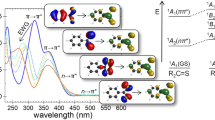Abstract
The UV and IR absorption spectra and the NMR and NQR spectra of certain isocyanates of three- and four-coordinated phosphorus have been investigated. The reciprocal effect of the phosphorus atom and the NCO group is discussed on the basis of spectral analysis, quantum chemical calculations of the π electron systems, and calculations of the normal vibrational forms. Comparison of the Υ(PO) frequencies in the IR spectra of the phosphorus isocyanates with the Taft σ gives a linear relationship which testifies to the predominant inductive effect of the NCO group on the P(O)R1R2 grouping. A similar relationship is observed between the resonance frequency γres in the NMR spectra and σ for C1P(O)R1R2 compounds. The effect of the phosphorus atom on the electronic system in the NCO group is shown by the hypsochromic shift of the absorption band in the210-mΜ region and an appreciable increase in its intensity, compared with alkyl isocyanates. This fact, which agrees with the NMR spectral data and the quantum chemical calculations, indicates the presence of conjugation in the P-N bond. We found the order of the P-N bond to be approximately 1.2. This partial double-bond nature of the P-N bond results from the interaction of the pπ electrons of nitrogen in the NCO group with the d orbitals of the phosphorus atom.
Similar content being viewed by others
References
R. F. Hudson, Structure and Mechanism in Organophosphorus Chemistry [Russian translation], Mir, Moscow, 1967.
D. Craig et al., J. Chem. Soc., 332, 1954.
H.H. Jaffe, Usp. khim., 26, 1060, 1957.
M. Kabatchnik, Tetrahedron, 20, 655, 1964.
D. Cruickshank, J. Chem. Soc., 5485, 1961.
J. Bell et al., J. Amer. Chem. Soc., 76, 5185, 1954.
E. Wagner, J. Amer. Chem. Soc., 85, 161, 1963.
E. N. Tsvetkov, D. A. Bochvar, and M. I. Kabachnik TEKh [Theoretical and Experimental Chemistry], 3, 3, 1967.
N. V. Eliseev, V. A. Sharpatyi, and A. N. Pravednikov, ZhSKh, 7, 511, 1966.
J. H. Letcher and J. R. Van Waser, J. Chem. Phys., 44, 815, 1966; 45, 2916, 1967.
E. Fluck, Z. Naturforsh., 19b, 869, 1964.
G. K. Semin and T. A. Babushkina, TEKh [Theoretical and Experimental Chemistry], 4, 835, 1968.
G. I. Derkach and E. I. Slyusarenko, ZhOKh, 37, 2069, 1967.
E. I. Fedin and G. K. Semin, ZhSKh, 1, 464, 1960.
G. K. Semin and E. I. Fedin, ZhSKh, 1, 252, 1960.
E. H. Eyster et al., J. Amer. Chem. Soc., 62, 3236, 1940.
K. Kimura, K. Katada, and S. H. Bauer, J. Amer. Chem. Soc., 88, 416, 1966.
E. Streitwieser, Molecular Orbital Theory for Organic Chemists [Russian translation], Mir, Moscow, 1965.
H. Suzuki, Electronic Absorption Spectra and Geometry of Organic Molecules, Acad. Press, N. Y.-London, 1967.
V. B. Zabrodin, A. A. Bagatur'yants, and S. G. Entelis, ZhFKh, 42, No. 9, 1968.
E. N. Tsvetkov, D. I. Lobanov, and M. I. Kabachnik, TEKh [Theoretical and Experimental Chemistry], 2, 458, 1966.
E. Fluck, Chemische Berichte, 94, 1388, 1961.
E. Fluck, Z. anorg. allg. Chem., 315, 181, 1962.
J. S. Thayer et al., J. Organomet. Chem., 5, 383, 1966.
E. I. Matrosov, ZhSKh, 7, 708, 1966.
Author information
Authors and Affiliations
Additional information
We are grateful to our colleagues at the Kazan Physicotechnical Institute AS USSR A. I. Rivkind, S. G. Salikhov, and I. A. Safin for recording the spectra.
Rights and permissions
About this article
Cite this article
Egorov, Y.P., Derkach, G.I., Kisilenko, A.A. et al. Special features in the chemical structure of phosphorus isocyanates. Theor Exp Chem 5, 403–408 (1972). https://doi.org/10.1007/BF00524568
Issue Date:
DOI: https://doi.org/10.1007/BF00524568



